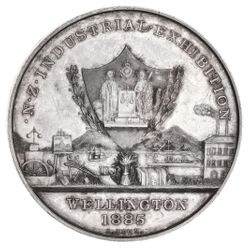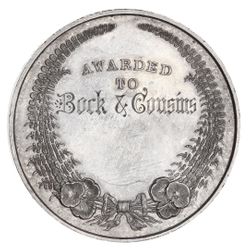Commemorative & Historical Medals 1865-1905
Lot 34 eSale Commemorative & Historical Medals 1865-1905
Estimate $1,000
Bid at live.noble.com.au
N.Z. INDUSTRIAL EXHIBITION, Wellington, 1885, struck in silver (42mm), by S.Kohn (Siegfried Kohn, Wellington), reverse inscribed 'Bock & Cousins' (M.1885/1). Obverse with dark toning, considerable underlying mint bloom, virtually uncirculated and very rare.
Ex Bock Estate.
The following two biographies courtesy Te Ara, The Encyclopedia of New Zealand, written by Robin Gwynn, were first published in the Dictionary of New Zealand Biography, vol 2, 1993:
ALFRED ERNEST COUSINS:
Born in the Channel Islands at St Helier, Jersey, on 24 October 1852, the son of Elizabeth Coutanche and her husband, Peter Cousins, a carpenter. From 1868 he served as an apprentice in London with Samuel Stevens, an engraver and brass plate manufacturer, until May 1874 when he sailed to New Zealand on the Conflict.
Arriving at Wellington in August, Cousins worked there as an engraver for Robert Burrett for 18 months, and for Lyon and Blair for 6? years. He then joined Bock and Elliott for 18 months, before entering into partnership with William Rose Bock. In 1883 he exhibited with the Fine Arts Association of New Zealand designs for a membership card and a certificate of merit. At the New Zealand Industrial Exhibition in Wellington in 1885 Bock and Cousins were awarded a silver medal for engraving, gaining first prize in both engraving and die-sinking, and lithographic and ornamental printing. However, the partnership was dissolved in 1889 under the financial strain imposed by Bock's pioneering chromolithographic production of Edward and Sarah Featon's Art album of New Zealand flora.
During his time with Bock, Cousins was introduced to work on postage stamps. In 1886 he engraved Tonga's first stamp issue and an issue for Samoa. In 1890 he entered a public design competition to produce two stamps to meet new postage rates on New Zealand's admission to the Universal Postal Union. Cousins's well-executed, large-scale watercolour designs stood out from a very ordinary field. One was accepted, and Cousins was given the task of engraving both values. It was a difficult task, since the design involved engraving Queen Victoria's head, for which previous dies used in the colony had been obtained from London.
This success opened up new horizons for Cousins. Between 1891 and 1895 he produced a set used by the Government Life Insurance Department, stamps for Samoa, Tonga and the Cook Islands, a new New Zealand halfpenny stamp design, a letter card and a ?1 postal note. By 1894 he had decided that his future lay in postage-stamp design. However, he was comparatively unsuccessful in the major stamp competition of 1895, winning only one first prize and one honourable mention. His hopes for furthering his career in this direction were dashed when the 1897 Tongan and 1898 pictorial New Zealand sets were sent to Britain for engraving.
Disappointed, Cousins tried his luck in Sydney, before returning in 1905 to Wellington, but success eluded him. Until his retirement in 1922 he worked as an engraver for Whitcombe and Tombs. Cousins had married Isabella Agnes McIlvride, the daughter of a farmer, at her home in Wainuiomata near Wellington on 22 May 1890. He died at Days Bay on 25 June 1935, survived by his wife and two sons.
Alfred Cousins was a competent craftsman, but he never greatly surpassed the assessment of his first reference: 'a steady, sober and industrious workman'. Lacking Bock's artistic grasp of the problems of design in miniature, he was unable to progress in his chosen field. He fell victim, too, to New Zealand's close relationship with Britain and that country's superior craftsmanship. His lasting disappointment is evident in a letter he sent to the Post and Telegraph Department as late as 1931, asserting that he could have produced dies for recent stamps and complaining that it was unjust 'to send work out of the country which could be done equally as well in NZ'.
WILLIAM BOCK (the name Rose was added later):
Born in Hobart, Van Diemen's Land (Tasmania), on 5 January 1847, the son of Thomas Bock and Mary Ann Cameron, nee Spencer, both of whom had been transported to Van Diemen's Land and subsequently pardoned. He was introduced to his craft by his family; his father was a notable engraver, lithographer and daguerrotypist, important for his paintings of Tasmanian Aborigines. William served an apprenticeship of 2-1/2 years in Hobart with his half-brother, Alfred Bock.
Failing to find employment on the Australian mainland, William Bock sailed to New Zealand on the Gothenburg in 1868. He arrived on 6 May in Wellington, where he was based for the rest of his life. After working with James Hughes for over five years, he went back to Tasmania and married his long-standing fiancee, Rebecca Finlay, in Hobart on 14 February 1874. On his return he managed the lithography and printing department of Lyon and Blair. In 1878 he rejoined Hughes for a year. He next set up his own business as an engraver and lithographic printer, first independently, then in partnership with Henry Elliott (briefly) and later with Alfred Cousins (1883-89). In the 1870s he was responsible for the design and preparation of the dies for the first fiscal and postage stamps to be produced wholly within the colony. In 1885 he designed the medals and certificates for the New Zealand Industrial Exhibition, at which Bock and Cousins were awarded a silver medal for engraving. They also gained first prize in engraving and die-sinking, and in lithographic and ornamental printing.
In the later 1880s William Bock personally supervised the first full book in chromolithography to be printed entirely in New Zealand. The magnificent Art album of New Zealand flora produced by Edward and Sarah Featon was published with 40 colour plates by Bock and Cousins in 1889. However, the strain imposed by the production proved excessive; further planned volumes did not appear, and the partnership with Cousins was dissolved that same year. Bock carried on business alone, initially as Bock and Company, and gradually recovered from debts of over ?800.
Bock's artistic flair was demonstrated in his work as medallist, stamp designer and engraver, and illuminator. His medals included several marking the 1901 Royal Visit to New Zealand and the 1913 HMS New Zealand medal. He contributed four values to the 1898 pictorial stamp issue, widely acclaimed as one of the contemporary world's most attractive. In 1906 he engraved the New Zealand International Exhibition set, the first locally produced large commemorative issue. Bock was the most important and innovative contributor to the development of New Zealand stamp production from 1875 to 1931. His work as illuminator included two jubilee addresses to Queen Victoria and other addresses to Pope Pius IX and to visiting members of the Royal Family: 'nobody of any note visiting New Zealand left without taking away some memento of Mr Bock's skill'.
A robust, cheerful and optimistic man of medium height, William Bock had a wide range of interests including singing, drama, cricket, the Anglican church and the artillery volunteers. He was vice president of the Master Printers' Association. In later years Bock began a partnership with his son William and at his death was supervising the apprenticeship of his grandson F.R.Bock, who was to continue the Bock engraving tradition in Wellington. Rebecca Bock died on 19 March 1915 and William died on 3 August 1932. They were survived by two sons and two daughters.
See also lot 2284 for a Volunteer Force Long Service Medal awarded to William R.Bock in 1907.
Estimate / sale price does not include buyer's premium (currently 22% including GST) which is added to hammer price. All bids are executed on the understanding that the Terms & Conditions of sale have been read and accepted. For information on grading and estimates please refer to the Buying at Auction advice.
Quick find
View a lot by number and sale.
Adjacent lots
Lot 32
NEW ZEALAND INTERNATIONAL EXHIBITION, Christchurch, 1882, struck in gilt (22mm), no maker, pierced at top ...
Estimate $200
Lot 33
N.Z. INDUSTRIAL EXHIBITION, Wellington, 1885, uniface, electrotype (silvered copper) (42mm), signed 'S.Kohn' (Siegfried Kohn, Wellington), ...
Estimate $140
Lot 34 This lot
N.Z. INDUSTRIAL EXHIBITION, Wellington, 1885, struck in silver (42mm), by S.Kohn (Siegfried Kohn, Wellington), reverse ...
Estimate $1,000
Lot 35
N.Z. INDUSTRIAL EXHIBITION, Wellington, 1885, struck in silver (42mm), by S.Kohn (Siegfried Kohn, Wellington), reverse ...
Estimate $600
Lot 36
N.Z. INDUSTRIAL EXHIBITION, Wellington, 1885, struck in silver (42mm), by S.Kohn (Siegfried Kohn, Wellington), reverse ...
Estimate $200

